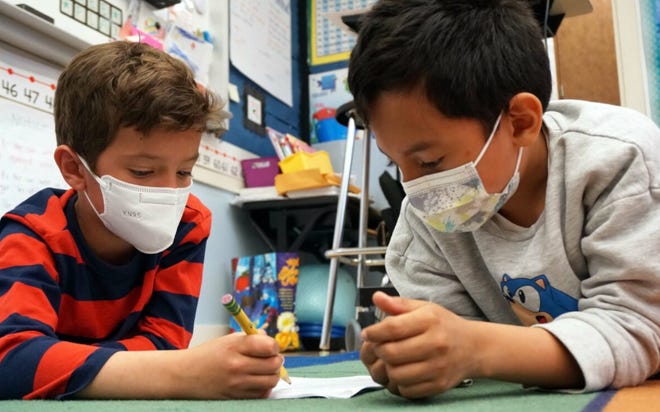Frustration after state legislature rejects bilingual education bill


A bill that would have helped school districts start more bilingual immersion programs faltered in the California legislature this month, dashing the hopes of many proponents of bilingual education.
Senate Bill 952 would have provided at least 20 school districts with technical assistance and grants of up to $750,000 each to establish programs to expand or establish bilingual immersion programs.
The Dual Language Immersion Program is designed to make both English-only and other-language speakers bilingual by teaching both languages to all students. Research shows that these programs improve the academic performance of English learners while benefiting native English-speaking students.
The bill was co-sponsored by Public Instruction Superintendent Tony Thurmond, the California Association for Bilingual Education, and Californian Together, a nonprofit advocating for students who speak languages other than English at home.
It received no formal opposition, but the 2022 budget did not include funds and could not move beyond Congress’ appropriations committee. A similar bill Thurmond introduced when he was in Congress passed in 2018 but was never funded or implemented.
Supporters of the bill expressed disappointment and frustration that the bill did not move forward, and the action will expand bilingual education, including the Global California 2030 Initiative, which has set a goal for the state to capture half of the total population. said it was inconsistent with the state’s stated goal of By 2030 he will be a K-12 student participating in a program proficient in two or more languages.
State Senator Monique Limon, who introduced the bill, said, “We are disappointed that SB 952 has not progressed into the legislative process.” Shown to improve memory, cross-cultural understanding.With our historic investment in K-12 education, we are making sure every student has the tools they need to reach their full potential. We have to make it available.”
Thurmond also expressed disappointment. Jonathan Mendick, a spokesman for the California Department of Education, wrote in an email: As a member of Congress and as Superintendent of Education, he was a continued supporter of multilingual and his bilingual programs, and SB 952 would have provided significant opportunities for schools and students across California. He would like to thank Senator Limon for his leadership and keeping the bill as through the process as possible. He also would like to thank CABE and He Californian Together for being outstanding partners and co-sponsors on the bill. Our work is not over and we will continue to promote bilingual immersion and multilingual programs. ”
Some proponents of the bill point out that there is not enough funding to meet the high demand of school districts wanting to start bilingual immersion programs. Last year’s budget established a grant program for bilingual immersion programs. According to information submitted to Congress, the California Department of Education has received 160 applications. The ministry said he could only subsidize 27 school districts and charter schools.
“California sees an opportunity to continue making significant investments in expanding our dual-language immersion programs to meet the demand for these types of programs and their effectiveness in meeting the needs of English and bilingual learners. Californians Together, a non-profit organization that advocates for students who speak languages other than English at home: “Funding the start-up costs of these research-based programs is especially important for increasing enrollment. It’s a perfect use of one-time funds, given the need to expand quality school options to cope with the decline.”
Abbey Kerins, director of special projects for the Newark Unified School District, said starting a new dual immersion program would be expensive, as it would require new materials and teacher training. Newark-Her Unified in the East She-Her Bay area just launched a dual Spanish and English immersion program last year. Like many such programs, this program begins as a kindergarten and her first grade program and is set to grow by one grade each year until the program is offered through eighth grade.
“The state has not done us very well in supporting bilingual immersion. With a global initiative of its own and with such visionary goals, they put us in that position. You’re not doing a good job leading to goals. but there is no money behind it. We have a community duty to respond to parents’ demands, but our response to their complaints should be ‘No, I can’t do anything, I don’t have the money’. not. ”
Anya Hurwitz is Director of SEAL, a non-profit organization that provides training and support to implement strong bilingual programs in schools statewide. She said SB 952 was a “step forward” towards realizing the Global California 2030 Initiative.
“Districts alone cannot do it. We need resources to build evidence-based practices for recruiting, training, and retaining bilingual teachers to scale our dual immersion programs,” said Hurwitz. “Multilingual education is a proven approach to transforming our education system from an unfair and expanding opportunity gap to one centered around the assets and needs of our children, the greatest promise of tomorrow. is.”
Advocates for bilingual education and English learners say they will continue to push to secure funding and legislative support to expand dual language immersion programs across the state.
“The bill has received very strong bipartisan support and there has been a great deal of interest in expanding the bilingual immersion program. , said Jennifer Baker, a legislative advocate for the Bilingual Education Association of California. “We are absolutely committed to continuing the conversation and trying to expand this in the future.”
Zaidee Stavely hosts EdSource’s Education Beat podcast covering school-related bilingual education, early childhood education and immigration.













